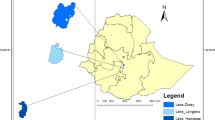Summary
Organisms of coli group which were isolated from intestines of oysters taken from clear uncontaminated sea water are studied biologically, particularly on the relation with those of human origin.
-
1.
Organisms of coli group isolated from intestines of oysters amounted 16 groups, 263 cultures; they are divided into three species A, B and C types.
-
2.
A and B types are those known as organisms of coli group of fish origin, and possess the following characteristics: rod-shaped, gramnegative, non-spore, gelatine-liquefaction, actively-motile, non-fermentation of xylose, rhamnose, dulcitol, raffinose, erythritol, with an optimum temperature from 25° C to 30° C.
-
3.
C type corresponds to Aerobacter aerogenes (Kruse) Beijerinck, but its presence in the intestines of oysters is not considered due to contamination of human feces.
-
4.
Organisms of coli group of fish origin differ from those of human origin in the following characteristics: motility; gelatine-liquefaction; fermentation of xylose, raffinose, rhamnose, dulcitol and other carbohydrates and polyhydric alcohols; production of indol; optimum temperature.
-
5.
Aerobacter aerogenes isolated from intestines of oysters is identified from organisms of coli group of human origin in its being positive for Voges-Proskauer's test.
-
6.
From the result of experiment on auto-disinfectious action of oysters, organisms of coli group of oysters origin are not considered to parasite temporarily in the intestines of oysters.
-
7.
It is considered that the frequently alledged presence of organisms of coli group of human origin in fresh oysters may due to bad handlings of material.
-
8.
The present author was unable to find human-origin coli group from oysters which were cultivated by the “Hanging Method” in clear sea, or cultivated normally in clear sea water, or in those that grow naturally in clear sea.
Similar content being viewed by others
Literature
Herdman, W. A., and Boyce, R., (1899): cited from The Japanese Journal of Hygiene and Infectious Diseases 24, 418, 1918.
Smith, Th. (1904): Ditto
Cumming, H. S., U. S. Hygienic Lab. Bull. 104, 1915.
Toyama, Y., Japanese Journal of Infectious Diseases 4, 101, 1928.
Yamaguchi, S., Kokumin Eisei, The National Hygiene 3, 4, 609, 1926.
Tsuchida, C., Jap. Journ. of Hyg. and Inf. Dis. 25, 259, 1926.
Fukuda, T., A graduation dissertation at Imp. Fish. Inst. 1927.
Darling, A., American Journal of Public Health 9, 844, 1919.
Darling, A., Ditto 13, 822, 1923.
Foote, C. J. A., Med. News 66, 320, 1895.
Wood, G. E. C., Brit. Med. Journ. 2, 666, 759, 852, 1896.
Fuller, C. A., U. S. Bureau of Fisheries Rep. 189, 1904.
Houston, A. C., Royal Sewage Commission 4th. Rep. 220, 1903.
Klein, E., Med. Off. Local Gov. Board of Gr. Brit. Rep., 24 App., 2, 109, 1874–5.
Ferguson, R. A., Virginia Health Bull. 11, 1909.
Clark, W. M., Rep. State Board of Health of Mass. 449, 1905.
Hewlett, R. T., Brit. Med. Journ. 1, 1082, 1903.
Geiger, J. C., Ward, W. E., and Jacobson, M. A. Journ. of Inf. Dis. 38, 273, 1926.
Akiba, T., Jap. Journ. of Hyg. a. Inf. Dis. 24, 418, 1928.
Hindman, E. F., and Goodrich, F. J., Am. Food Journ. 12, 611, 1917.
Round, L. A., Am. Journ. Pub. Health 6, 686, 841. 1916.
Escherich, Th., Die Darmbakterien des Neugeborenen und Säuglings, Stuttgart 1886.
Escherich, Th. Society of American Bacteriologists: Method for Pure Culture Study of Bacteria, 1926.
Escherich, Th. Standard Method of Water Analysis, 1921.
Burk, A., Centralbl. f. Bakt. I, Orig., 45, 577, 1908.
Segin, A., Centralbl. f. Bakt. I, Orig., 34, 206, 1897.
Kodama, T., and Suzuki, C., Jap. Journ. of Hyg. a. Inf. Dis. 11, 4, 1915.
Yamanaka, S., and Tan, C., Juzen-Kai Zasshi, No. 146, 1918.
Furukawa, S., Saikin-Gaku-Zasshi, Journ. of Bacteriology, No. 258, 277, 1917.
Eyre, J. W. H., Bacteriological Technique, 1916.
Takeuchi, M., Bacteriology and Immunology (Kinsei Saikingaku oyobi Menekigaku), 1930.
Takeuchi, M. Government of Formosa, Report of 15th. Meeting of Association of Water Supply, 113, 1925.
Velde, van de, Bull. de L'Acad. Royal de Med. Belgique 261, 1897.
Wolf, S., Centralbl. f. Bakt. I., 25, 311, 1899.
Jatta, M., Zeitschr. f. Hyg. 33, 185, 1900.
György, P., Centralbl. f. Bakt. I, Orig., 84 321, 1920.
Geisse, A., Centralbl. f. Bakt. I, Orig., 46, 359, 1908.
Rothberger, C. J., Zeitschr. f. Hyg. 34, 79, 1900.
Adachi, K., Fukuoka Igaku Zasshi, Journ. of Med. of Fukuoka. 15, No. 2, 1922.
Aoki, K., Tohoku Igaku Zasshi, J. of Med. of Tohoku. 2, No. 2, 3, 131, 1921.
Yaoi, H., Jap. Journ. of Hyg. a. Inf. Dis. 20, 1, 1924.
Fujiwara, K., Kyoto Igaku Zasshi, Journ. of Med. of Kyoto. 18, No. 1, 9, 1922.
Altmann, K., Centralbl. f. Bakt. I, Orig., 45, 217, 1908.
Mac Conkey, A., Journ. of Hyg. No. 9, 86, 1905.
Mac Conkey, A., Ditto No. 5, 333, 1909.
Rogers, L. A., Clark, W. M., and Evans, A. C., Journ. of Inf. Dis. 15, 99, 1914.
Clemesha, W. W., Centralbl. f. Bakt. I, Ref., 56, 510, 1913.
Chen, Chong Chen and Rettger, L. F., Centralbl. f. Bakt. I, Ref., 71, 557, 1921.
Skinner, Ch. Edw., and Murray, T. J., Centralbl. f. Bakt. I, Ref., 77, 507, 1924.
Hinard, G., Chem. Abst. 24, 1, 4100, 1930.
Schottelius, L. M., Arch. f. Hyg. 34, 210, 1899.
Schottelius, L. M., Ditto 42, 48, 67, 177, 1902.
Metchnikoff, E., cited from “Kolle u. Wassermann, Handb. d. Pathog. Mikroorg. 6, 468–509, 1931”.
Moro, E., Münchn. Med. Wochenschr. 2001, 1906.
Buice, W. A., Schested, H. C., and Dienst, R. B., Journ. of Inf. Dis. 40, 351, 1927.
Author information
Authors and Affiliations
Rights and permissions
About this article
Cite this article
Tanikawa, E. Biological studies on the organisms of coli-group isolated from the intestines of oysters. Archiv. Mikrobiol. 8, 288–306 (1937). https://doi.org/10.1007/BF00407202
Received:
Issue Date:
DOI: https://doi.org/10.1007/BF00407202




